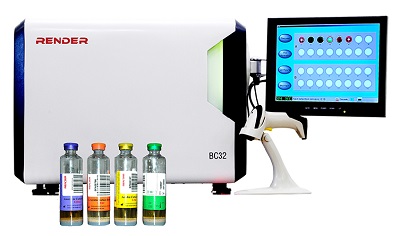Blood Culture - Collection, Venipuncture, Volume, Culture, Anticoagulant, Media
Introduction to Blood Culture
Blood culture is a diagnostic procedure used in the identification of etiological agents in systemic infection. It is mostly done in cases of bacteremia, septicemia, fungemia, viremia, or in cases suspected of infection by Salmonella spp. such as Salmonella enterica serotypes Typhi, Paratyphi A, Paratyphi B, and Paratyphi C.
Disseminated forms of Mycobacterium tuberculosis combined with a subculture in Lowenstein-Jensen (LJ) media increase the sensitivity of diagnosis.
In such cases blood must be collected for blood Culture before antibiotic therapy and when the temperature begins to rise.
Collection method of Blood Culture
The collection procedure for specimens for the blood culture includes:
Venipuncture
The procedure for venipuncture for the blood culture sample collection includes:
Choose the vein to be drawn by touching the skin before the infection
Cleanse the skin using 70% alcohol over the selected site in a circle, approximately 5 cm in diameter
Starting in the center of the circle, apply a tincture of Iodine (Iodine in alcohol) or chlorhexidine
Allow drying on the skin for at least 1 minute
Insert the needle into the vein and draw the required amount of blood
Remove the needle and cleanse the site with 70% alcohol again
Volume of blood to be drawn
The volume of blood to be drawn for the blood culture sample collection includes:
1. Adults = 10-20ml of blood per culture is recommended
2. Children = 1-5ml of blood per culture is recommended
less than 1 ml is not adequate but can detect bacteremia in some adults due to high levels of bacteremia
No. of blood cultures
Usually, 2-3 blood cultures are sufficient to achieve optimum blood culture sensitivity
Timing of collection
In intermittent bacteremia, the presence of bacteria in the blood is unpredictable. So, 2 or 3 blood cultures are spaced an hour apart.
In emergency cases, this is not possible. So, collected 40ml of blood at one time, and 20 ml from each venipuncture site.
Anticoagulant
Anticoagulants can be inoculated directly into the culture medium for the blood culture sample collection. Anticoagulant such as SPS (sodium Polyanethol Sulfonate) at 0.025% to 0.05% is best for use instead of Heparin, EDTA, and Citrate.
SPS also has anticomplementary and antiphagocytic activity while SPS may inhibit some strains of Neisseria spp., Gardnerella vaginalis, etc.
Blood should not be allowed to clot as bacteria may be entrapped with a clot and may remain undetected.
Blood culture
Dilution
Dilution ratios used for blood culture are:
A 1:10 ratio of blood and medium has traditionally been used
A 1:5 ratio is used nowadays
Blood culture media
Blood culture media for blood culture are designed to recover even a single microorganism. Commonly used media are:
Soybean Casein Digest Broth
Trypticase Soy Broth
BHI broth
Supplemented peptone broth
Thioglycolate broth
Columbia broth (specialized broth)
Brucella broth (specialized broth)
Incubation of culture media
Incubation might require up to 4 weeks depending upon the nature of microorganisms at 35-37°C. Cultures are examined and sub-cultured daily for 7 days and then twice a week for up to 4 weeks.
Constant agitation of the bottle during the first 24 hours of incubation enhances the growth of most aerobic bacteria during the blood culture.
Interpretation of Blood culture results
Growth, for the blood culture, is indicated by changes in turbidity, pellicle formation, gas bubble formation, odor, hemolysis, clot formation, etc.
* Automated Blood Culture systems such as The BD BACTEC™ is an advanced procedures used in the diagnosis of systemic infection. It utilizes fluorescent technology to detect the growth of organisms in the blood culture bottles.

Fig: Automated Blood Culture system (Source: renderbio)
Subculture
A loop full of incubated medium is sub-cultured in MacConkey agar (MA), blood agar (BA), and chocolate agar (CA) for further identification. Incubation of subculture, during the blood culture, is done at 35°C for BA, CA, and MA for 24-48 hours in gas.
Probable contaminant
The probable contaminant that can be found during blood culture are:
Growth of Bacillus spp. (except Bacillus anthracis), Coagulase-negative Staphylococcus (CoNs), Corynebacterium spp., Propionibacterium acnes in one of several cultures
Growth of multiple organisms from one of several cultures (polymicrobial bacteremia is uncommon)
the organism causing infection at a primary site of infection is not the same as that isolated from a blood culture.
Probable pathogen
The probable pathogen that can be found during blood culture are:
Growth of the same organism in repeated cultures obtained either at different times or from different anatomic sites
Growth of organisms such as Enterococci spp., gram-negative rods in patients suspected of endocarditis or with clinical gram-negative sepsis respectively
Growth of certain microorganisms such as Enterobacteriaceae, Streptococcus pneumonia, Streptococcus pyogenes, gram-negative anaerobes
Isolation of commercial microbial flora from blood cultures of immunocompromised patients